Looking for some larger houseplants to add to your home? Today we’re going to talk all about Umbrella Plant Care (also known as Schefflera). These beautiful, easy to grow plants can grow up to 15 feet tall!
Table of Contents
Umbrella Plant Basics
The umbrella tree has a variety of names – parasol plant, octopus tree, and Hawaiian schefflera are a few. They are tropical plants that are a great houseplant!
They’re very hardy and can grow beautifully even when neglected. Great for beginners who want a bigger plant!
Schefflera Actinophylla vs. Shefflera Arboricola
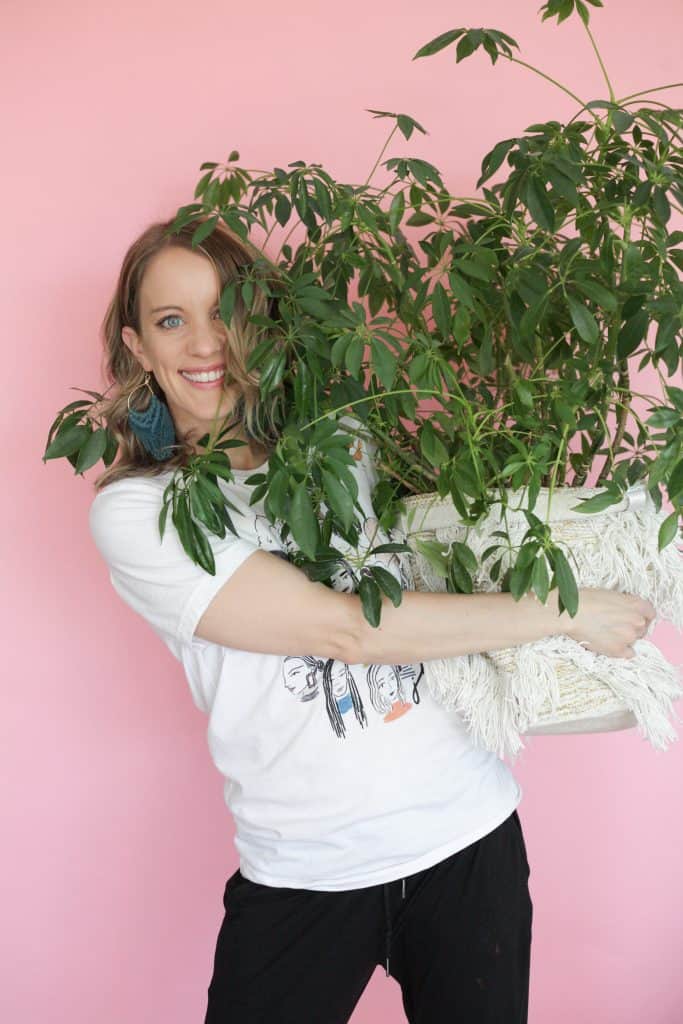
This post includes affiliate links.
There are hundreds of different varieties of Schefflera houseplants (like most plants!) but there are 2 main varieties of Schefflera. These are the Schefflera Actinophylla and the Shefflera Arboricola.
The Schefflera Actinophylla is the most common umbrella plant that you’ll see. Actinophylla plants usually have leaves which are longer than 4-5 inches. (If you’re looking for other large plants check out the Rubber Plant or Fiddle Leaf Fig!)
Shefflera Arboricola is the smaller version of this plant. The common name for these plants is the Dwarf Umbrella Tree. The Dwarf Schefflera is the kind that I personally own. The leaves on this type are around 4-5 inches or smaller in length.
When it comes to flowers, the Dwarf Umbrella Plants will produce greenish-white or cream flower spikes. The Schefflera actinophylla flower spikes are where the name “octopus plant” comes to be. These are cluster of red, pink or white that hang down from the tip of branches.
These flowers often turn into bright orange berries (but take note – they aren’t edible!!).
Schefflera Plant Care Tips + Trick
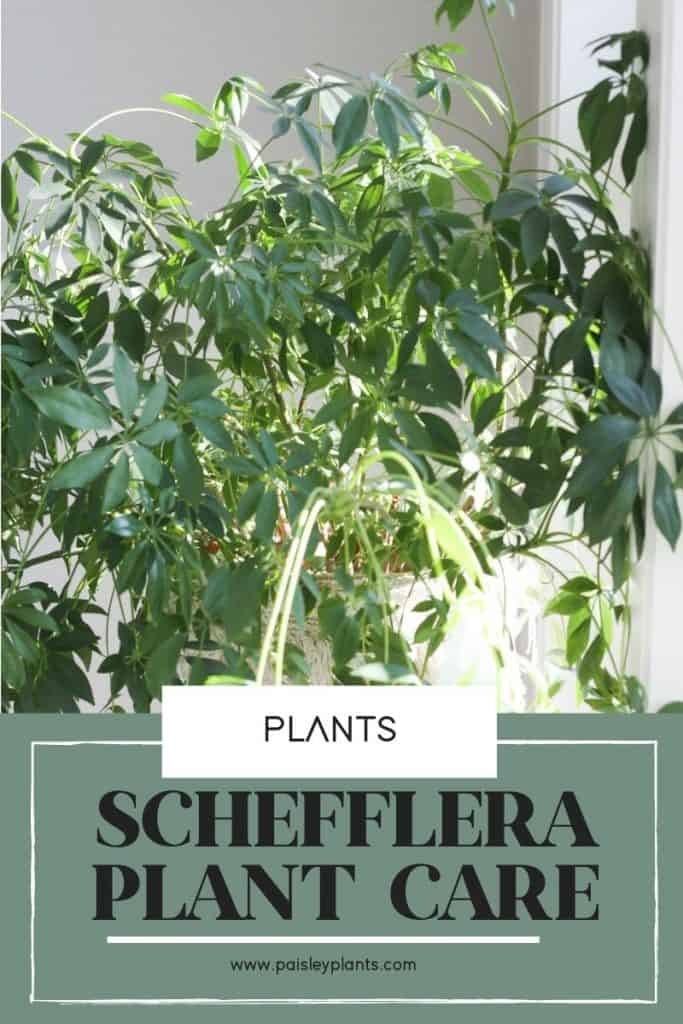
I’ve had my Umbrella plant for so long I don’t even remember where it came from! It has been a staple in our home and one that I don’t have fuss with or worry about it dying. These are great, easy to grow houseplants!
Water
Umbrella plants need different amounts of water depending on the time of the year. During the summer months, or the growing season, they typically need to be watered weekly. When cooler weather and winter months arrive they need to be watered about every 2 weeks. Always double check your plant’s soil before watering. If it’s dry to the touch, go ahead and water but if it’s still moist, wait a few more days!
Like most indoor plants, they need to be in pots with good drainage holes. They prefer to be underwater than overwatered so good drainage is key to happy plants. Too much water and not enough drainage can cause root rot to happen which can lead to major problems.
Umbrella plants aren’t very picky with how they’re watered (over the soil, bottom watering or water baths), just make sure the top inch of soil is dry before giving them any water. Never water soggy soil!
Light
Umbrella plants do best with a good amount of bright indirect light. They like light but don’t do well with too much direct sunlight.
If it is getting leggy or floppy it’s likely not getting enough light. Don’t fret too hard if that happens – simply move it into a spot that get more light! One common problem with plants that are getting enough light is getting yellow leaves. This is a telltale sigh to move it to a spot that gets more light!
If you live where it’s warm (or at least has warm summers, like we do), you can bring it outside for the summer months. If you put this outdoor in the summer just be sure it gets a good amount of shade. Too much bright light can burn your plants leaves.
Soil
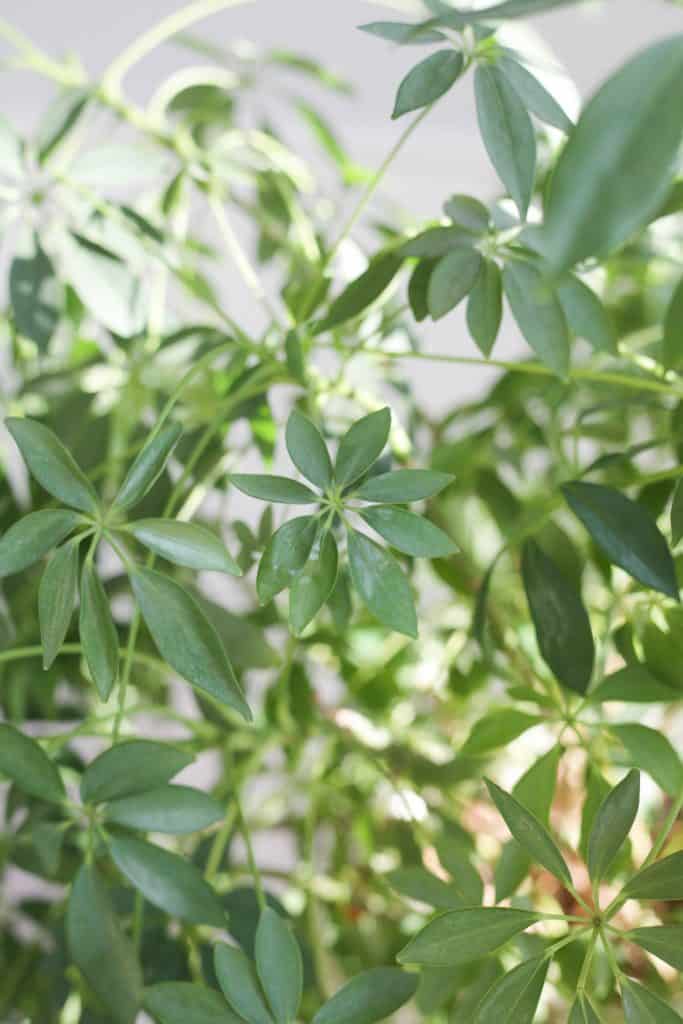
Schefflera plants to best in a rich, well draining sandy soil. As mentioned above, they don’t like to be too wet.
Temperature and Humidity
Schefflera plants are tropical plants that come from warm climates. This means you’ll want to keep them in warm temperatures. These plants don’t like to be in places cooler than 60 degrees Fahrenheit so keep that in mind especially if you live in a cooler climate. Be sure to keep them away from drafty spots, especially during the winter months.
Your indoor umbrella plant will also do best with high humidity levels. While higher humidity can be hard to mimic inside, one great spot for these plants are the bathroom! The natural humidity will create optimal conditions for your plant.
Toxicity
The Schefflera is toxic to dogs and cats (according to ASPCA).
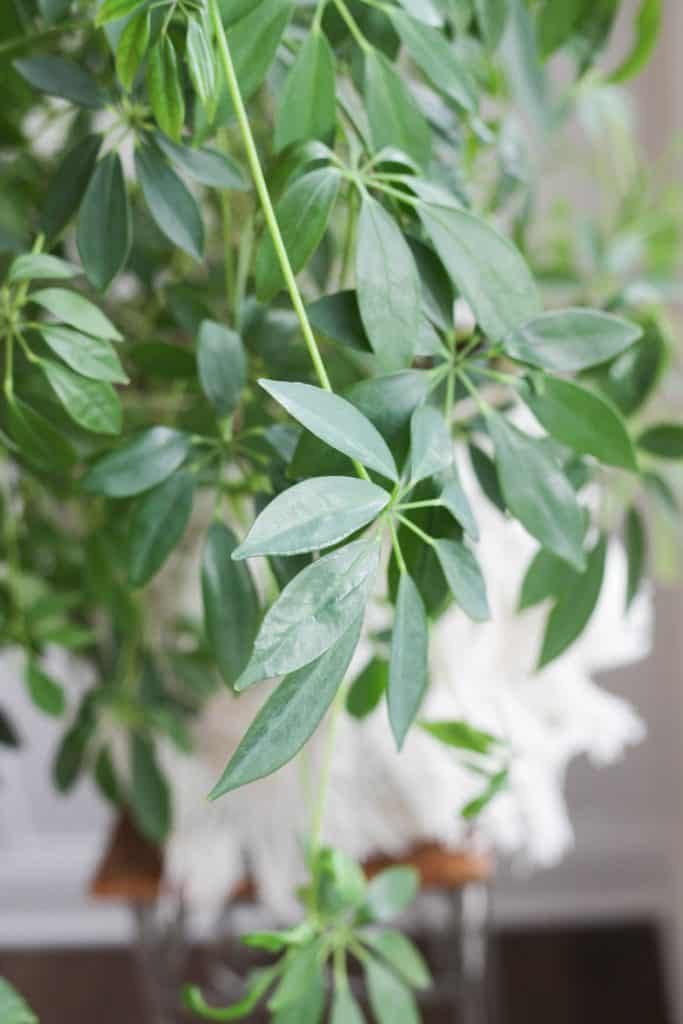
Common Pests
Unfortunately, most house plants have the likelihood of having some sort of pest problem at one point or another. However, with proper care most pest problems can be kept at bay. A few to keep an eye out for with your umbrella plant are:
- aphids
- spider mites
- scale insects
- mealy bugs
As a general rule of thumb, check your plant every time you water it. It doesn’t need to be a deep dive inspection of every single inch but check the leaves and underside of leaves and the soil to see if you see anything.
Pruning and Re-potting Rubber Plants
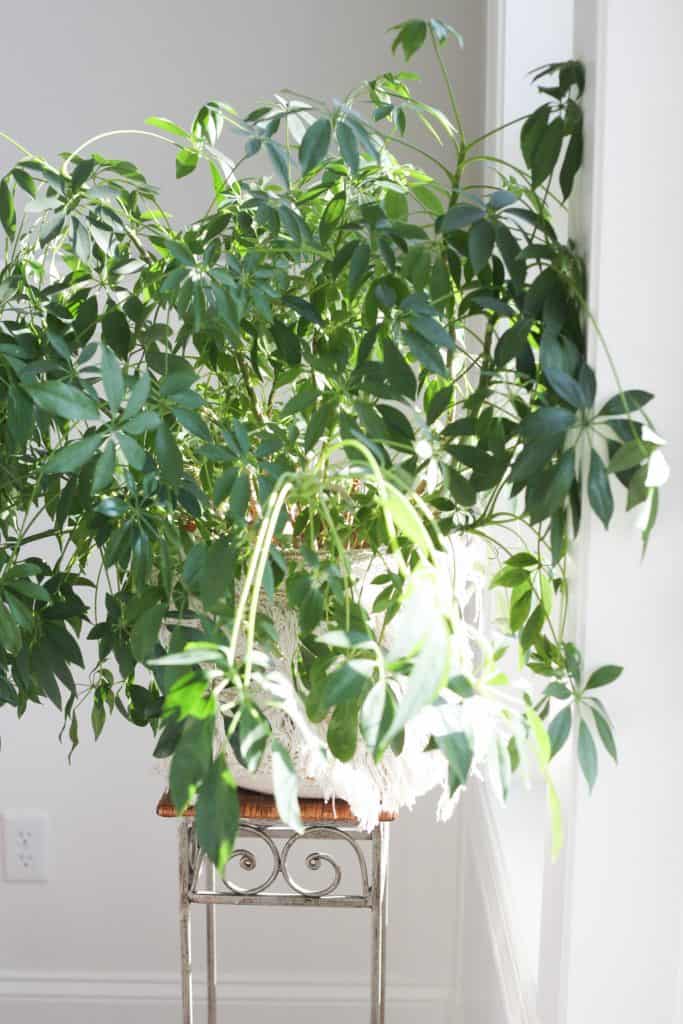
As your Umbrella Plant matures, there’s a good chance you’ll need to prune it. Clearly ours needs a good pruning! It’s getting crazy!
First, determine what shape you ultimately want your schefflera to take. Do you want it to be tall and skinny? Prune new stems close to the base.
Want it to be less wide? Trim just above a leaf node.
Scheffleras can handle some super aggressive trims so don’t hesitate to get a little scissor happy! It’ll grow back eventually (just like our hair!). Good trims encourage new growth too! A mature plant will respond well to a healthy trim now and then to encourage new leaves to form.
Propagating
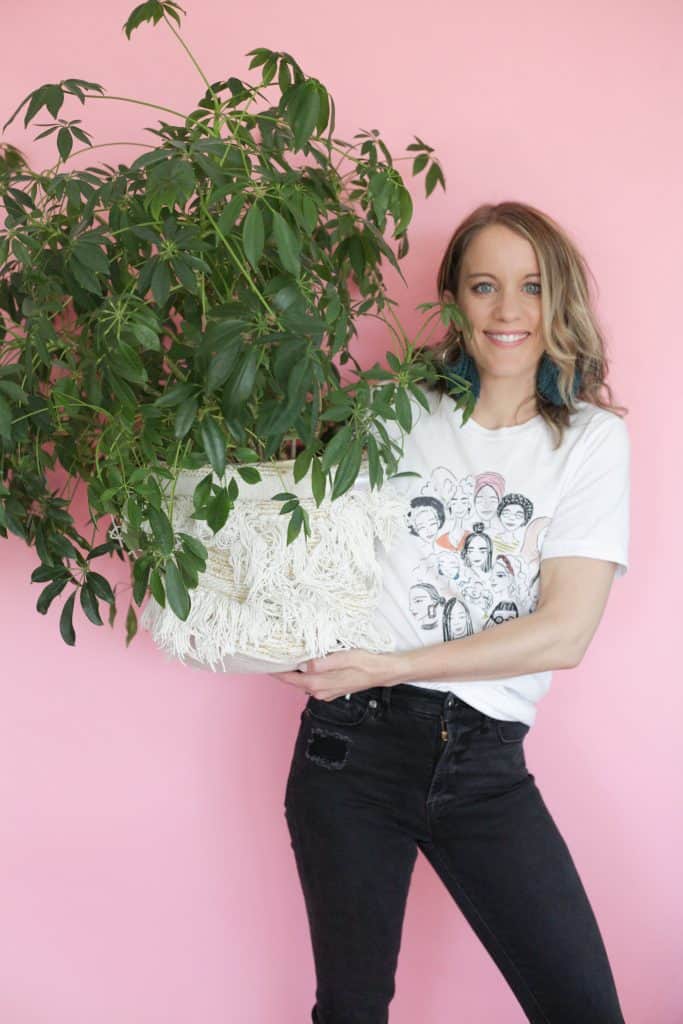
Some say propagating schefflera is pretty difficult while others say it’s easy! It’s best to do on a healthy, fuller plant that has ample growth to give. With that being said, here’s how to do it:
- Clip off a stem near the base of the plant.
- Fill a pot with soil.
- Dip the stem cuttings into rooting hormone.
- Put in pot, covering it with soil.
- Water.
I tested this out and it was so easy to do!
You can also do water propagation. Basically instead of planting it directly in soil, you’ll fill a jar or propagation station with water and wait for the roots to form before you pot it!
Where to Buy
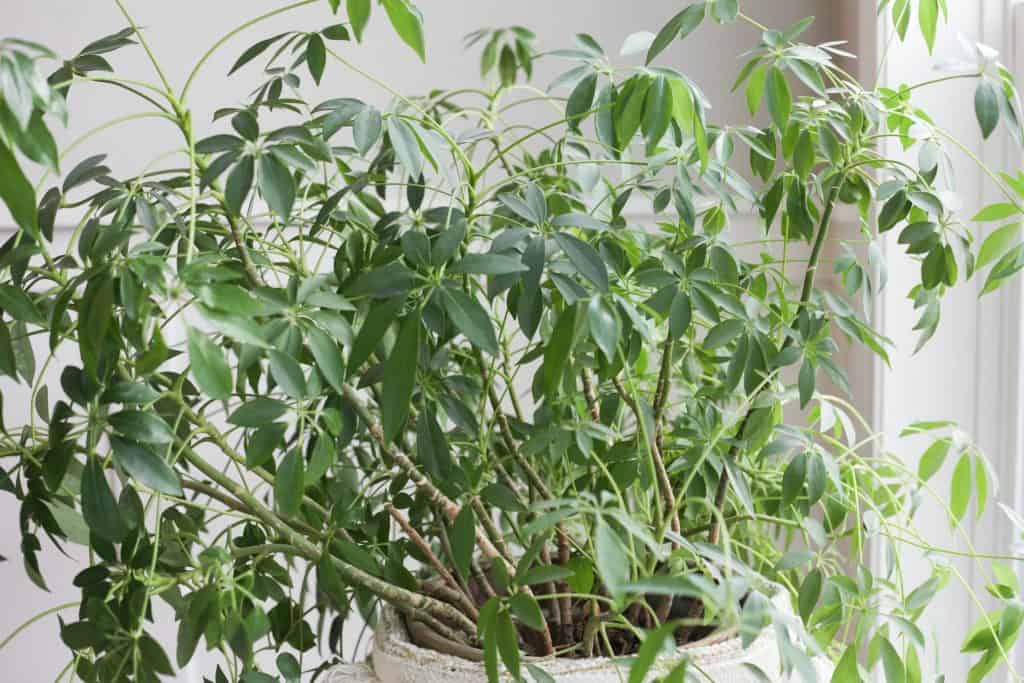
There are many places to buy your new schefflera.
Overall, the Schefflera plant care is fairly simply and these plants are some pretty amazing plants that would be a great addition to your home! I hope I helped you fully understand how to take care of them!

